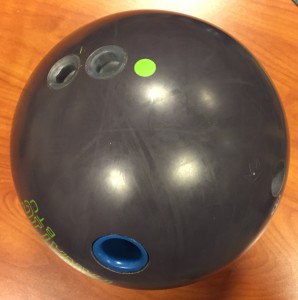Is the BTU Truly Better Than Urethane?

First Impressions
Yes, the Brunswick Fanatic BTU is better than urethane. It will be easy to see why.
Our Tester:
Brandon Hinderer is a PBA Member as well as Brunswick and Vise Staffer.
Power Player: 425 rpm
PAP: 5 3/8 & 7/8 up
Axis tilt: 10-15 degrees
Axis rotation: >45 degrees
Thanks to Limerick Bowl in Limerick, PA.
“Keep in mind that coverstock accounts for 70% of ball reaction, but the core creates the dynamic shape of the reaction. Your driller will alter the shape to suit your game.”
Test Pattern:
40ft THS, 22ml, 12:1 ratio
Value
8/10
The Fanatic BTU is moderately priced and while it is better than urethane, it’s still in the same arena. Hence, for some bowlers it will be more versatile than others. You could argue the value but I’m leaving it there.
Specs
The Brunswick Fanatic BTU uses the BTU (Better Than Urethane) coverstock with the Low Differential I-Block Symmetrical core. You may recognize the shape from previous balls including the Versa-Max. RG is 2.601 and diff is .030.
Overall
8.5/10
I have to give kudos to Brunswick for making the BTU work. Urethane has been all the rage for several years now with a comeback. Too little oil, too much hand, yada yada… However, on the flip side of every good thing like a smooth controllable early reaction, there are lots of down sides. People with low revs can’t get urethan balls to carry well. They read very early so low oil situations are actually not always conducive to the urethane reaction. You need to find some head oil so you may get stuck with very little reaction down lane once you do so. It drags oil down and you can get real carry down issues. If you’re Belmo, you can win tournaments with polyester. Look at Jesper Svensson throwing urethane everywhere. The rest of us can’t quite manage that type of carry.
Now to the BTU specifically. This ball really is different and for the better. I’m not going to get into the science side but from the testing we saw a smooth move. However, one that had more energy downlane. We didn’t see a ball that read the lane and started to hook at 25 ft like most urethane. It actually had some push while it was trying to turnover. That allowed it to have more energy. It kind of looked more like an early reactive resin reaction than a urethane one.
Additionally – which I think is a major benefit – it didn’t destroy the lane by pushing oil down. It actually absorbs oil similar to reactive which keeps the lane in shape longer. When you look at the Digitrax analysis, you can easily see a smooth yet “unurethane” like characteristics. We have been using Digitrax for over 6 years for our reviews so we are very familiar with the typical urethane track. In this case, since the breakpoint is so much further downlane, the ball shape is more reactive-like. To confirm this, the Digitrax showed an average breakpoint of 39.5ft with an average entry angle of 6.7 degrees. Compare that historically to other urethane pieces that are usually 36 feet or less and 5.5 degrees or less on this condition.

In the shots that didn’t make the cut, you realize that this is still “urethane-like” as misses to the outside tend to flag the headpin. Despite everything we said, it’s not storing the kind of energy reactive balls do so you can’t go spraying this thing around. However, it will keep you safer on tough conditions where you just want to bring the control more towards you, meaning you want more front to back lane control which tends to be more critical on sport patterns.
Final Thoughts… Brunswick has provided a legitimate option for those looking for or needing a urethane like reaction. The Fanatic BTU brings something different than the run of the mill urethane pieces since it has a later breakpoint and doesn’t carry oil down the same way. It will have more punch down lane while still offering control and doesn’t destroy the pattern. Bowlers with a lot of hand will probably like this ball a whole lot more than strokers since they will get a 90s ball reaction (nee smooth) while still being able to rip on it.


